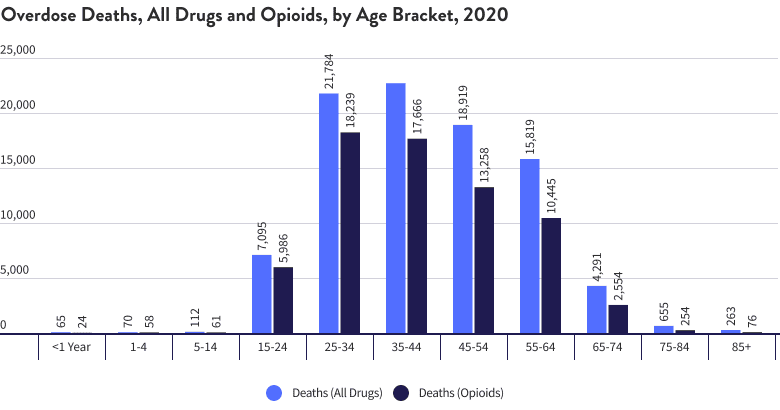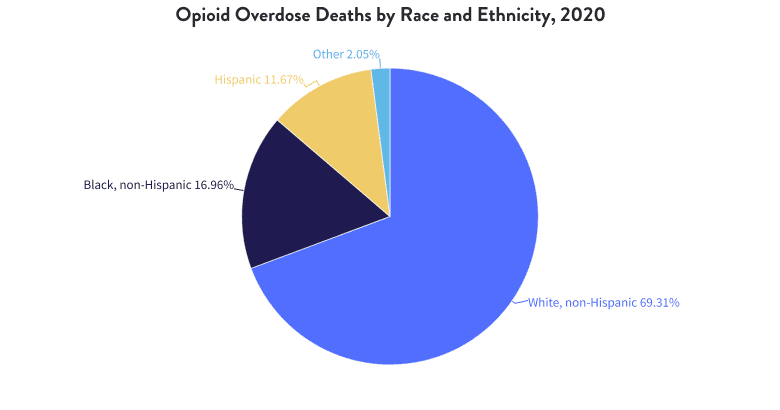The drug crisis has stolen precious lives for many years. As of 2020, there have been over 932,000 fatalities associated with drugs in the U.S. Numbers from the Centers for Disease Control (CDC) show that overdose deaths have been increasing through the years. In 2020 alone, drug overdose deaths totaled 91,799. Almost 75% involved opioids. Out of the opioid-related deaths, over 82% were synthetic, excluding methadone. From 2018 to 2019, only two states saw a decrease (Arkansas and Michigan). From 2019 to 2020, 12 states had stable rates, but the remaining 38, plus the District of Columbia, showed an increase.
Overdose Deaths by the Numbers
 AC
ACAngelique Cruz
Researcher
Angelique Cruz, a researcher and content producer at MoneyGeek, specializes in writing informative content on personal, auto and home loans. She has extensive experience developing content on macroeconomics, financial statistics and behavioral finance. She also has a 10-year background in management consultancy. Cruz has a psychology degree from Ateneo de Manila University.
 AS
ASAliha Strange
Freelance Web Content Editor
Aliha believes that knowledge is power. Her desire is to help others who grew up with socioeconomic disadvantages, like herself, learn financial literacy, avoid predatory lending and build toward generational wealth. As a freelance web content editor, she’s empowered to use her creative background and technical strengths to craft informative content. Aliha is a graduate of Seattle Pacific University, where she studied English literature and creative writing. She had the privilege of studying at the University of Salamanca in Spain during her college career, where she developed an appreciation for global perspectives, language and culture. She has over three years of experience as a legal assistant with Davis Wright Tremaine LLP in the Real Estate and Litigation practice groups. In her personal time, she enjoys living in sunny California and serving the homeless community.
MoneyGeek is dedicated to providing trustworthy information to help you make informed financial decisions. Each article is edited, fact-checked and reviewed by industry professionals to ensure quality and accuracy.
Editorial Policy and StandardsUpdated: February 11, 2024
Featured Experts:
 S
SShad B. Ewart
Professor and Administrator at Anne Arundel Community College
Shad B. Ewart has been a professor and administrator at Anne Arundel Community College since 2001. Before that, he was a business professor at Mount Vernon College in Washington, DC. At Anne Arundel Community College, he has served as Department Chair and Director of Business Programs. As chair, he designed the curriculum for the Business Support Specialist program and the Transportation Logistics and Cargo Security program. Many of his curricular innovations have been replicated in other parts of the college. Mr. Ewart has also served the college on various committees, including chairing the Academic Forum and other college committees. Professor Ewart has also been responsible for designing and developing the first course to explore the entrepreneurial opportunities created by the legalization of cannabis for medical use in the state of Maryland. Many students who have successfully completed the course have already found employment in the industry, have started their own businesses, and, in one case, own a dispensary. Professor Ewart is currently developing the first college credit program for those interested in entry-level jobs in the cannabis industry. Professor Ewart has also developed cannabis-related training and curriculum for several other educational institutions and cannabis organizations on the topics of entrepreneurship, social equity and racial injustice, the endocannabinoid system, cannabis cultivation basics, dispensary management and operations, federal and local laws and regulations, the history of cannabis, and sustainability issues in the cannabis industry.
 JM
JMJordyn Mastrodomenico
Clinical Director at ChoicePoint
I am the Clinical Director at Choice Point- A Co-occurring Addiction Treatment Center. Here at Choice Point, we work with clients to create Treatment Plans focused on relapse prevention. I am highly skilled in working with individuals who suffer from Substance Abuse and Mental Health Disorders to guide them toward a healthy lifestyle through their recovery journey.
 LR
LRLois Ritter
Ed. D., MS, MA, MS-HCA, PMP, CHDA, Teaching Associate Professor at the University of Nevada, Reno
Lois Ritter has worked in education, health care and research for over 25 years. Her work in education includes teaching in academic settings as well as in healthcare settings. Her research includes working in human trafficking, substance abuse and telehealth. Many of these studies have been statewide or national multi-year and multi-site projects.
 DV
DVDr. Veronica Vernon
PharmD, BCPS, BCACP, NCMP, Assistant Professor at Butler University
Veronica Vernon, PharmD, is the Assistant Professor of Pharmacy Practice at Butler University College of Pharmacy and Health Sciences. Dr. Vernon received her Doctor of Pharmacy degree from Purdue University. She collaborates with Dr. John Hertig, Chair of the Board of the Alliance for Safe Online Pharmacies (ASOP Global).
 DO
DODr. Ijeoma Opara
Associate Professor at Yale School of Public Health
Dr. Ijeoma Opara is an assistant professor at Yale's School of Public Health. Her research interests focuses on substance use and HIV prevention, empowerment for Black girls and women, and racial health disparities. She is also the director of The Substance Abuse and Sexual Health Research Lab, which highlights strengths-based prevention research for urban youth. Dr. Opara received her PhD from Montclair State University, her Master of Social Work from New York University and her Master of Public Health from New York Medical College. Dr. Opara holds visiting faculty and affiliate appointments at Yale University, University of Michigan, and New York University.
 AC
ACAngelique Cruz
Researcher
Angelique Cruz, a researcher and content producer at MoneyGeek, specializes in writing informative content on personal, auto and home loans. She has extensive experience developing content on macroeconomics, financial statistics and behavioral finance. She also has a 10-year background in management consultancy. Cruz has a psychology degree from Ateneo de Manila University.
 AS
ASAliha Strange
Freelance Web Content Editor
Aliha believes that knowledge is power. Her desire is to help others who grew up with socioeconomic disadvantages, like herself, learn financial literacy, avoid predatory lending and build toward generational wealth. As a freelance web content editor, she’s empowered to use her creative background and technical strengths to craft informative content. Aliha is a graduate of Seattle Pacific University, where she studied English literature and creative writing. She had the privilege of studying at the University of Salamanca in Spain during her college career, where she developed an appreciation for global perspectives, language and culture. She has over three years of experience as a legal assistant with Davis Wright Tremaine LLP in the Real Estate and Litigation practice groups. In her personal time, she enjoys living in sunny California and serving the homeless community.
MoneyGeek is dedicated to providing trustworthy information to help you make informed financial decisions. Each article is edited, fact-checked and reviewed by industry professionals to ensure quality and accuracy.
Editorial Policy and StandardsUpdated: February 11, 2024
Advertising & Editorial Disclosure

Fast Facts on US Overdose Deaths
Unfortunately, there are extensive data regarding overdose deaths involving opioids. Here are the essential points to keep in mind:

Out of all drug overdose deaths from 1999 to 2020, 564,000 involved opioids.
Drug overdose deaths in the U.S. increased by 15% from 2020 to 2021. Those involving opioids went from 70,029 in 2020 to 80,816 in 2021.
There were three opioid waves, which started in 1996, 2010 and 2013. The opioids involved in each of these were prescription opioids, heroin and fentanyl, respectively.
Overdose deaths vary between age, gender and ethnicity. Numbers show that the highest count appears in those between 35 to 44, males and White Non-Hispanics.
California had the highest number of opioid deaths in 2020. However, West Virginia, despite only having 1,129 recorded incidents, has the highest death rate at 70 per 100,000 population.
Total Number of Overdose Deaths
Drug overdose has wreaked havoc on Americans across the country for years. The crisis has gotten to the point where several thousand Americans die each year from drug overdosing. The graph below details the numbers.

It's worth noting that each year reported numbers have fallen below the predictions. However, overdose deaths, in general, have been increasing since 2017. The only exception is 2018, when figures (reported and predicted) went down by around 4.2%.
The most significant increase occurred between 2019 and 2020. Overdose deaths rose about 30%, from 71,130 to 92,478. Numbers continued to increase in 2021. Although it uses provisional data, 2021 numbers show that overdose deaths are almost 17% higher than the previous year.
Fentanyl contaminates more illicit and counterfeit prescription drugs, putting more people at risk of overdosing. The possibility of dying from taking one pill is higher if it's laced with fentanyl.
Overdose Deaths by Drug Type
Drug use has been present in the U.S. for several decades, and overdose deaths are an ongoing concern. However, some drugs result in more fatalities than others. The graph below explores this further.

Overdose deaths connected to fentanyl contributed the most for both years, comprising around half of the total fatalities. The contributions of the other drugs were as follows:
- Psychostimulants (Meth): 23.12% (21.18% in 2020)
- Cocaine: 17.26% (17.17% in 2020)
- Natural/Semisynthetic (Prescription): 9.50% (11.82% in 2020)
The general trend shows that overdose deaths increased from 2020 to 2021. The sole exception is those involving natural or semisynthetic ones (prescription drugs) — fatalities decreased slightly from 13,722 to 13,503.
Although there were 13,404 additional overdose deaths involving fentanyl in 2021, the most considerable difference was from the use (or misuse) of psychostimulants (meth). The number of fatalities increased by almost 34% from 2020.
Overdose Deaths by Age Bracket
Poisoning, which includes overdosing, is the leading cause of preventable home death and injuries across all ages.
MoneyGeek analyzed overdose statistics in several ways — one of which was age. The bar graph below shows when overdose deaths were more likely to occur and how many involved opioids.

Source: National Safety Council
Although the number of overdose deaths varies between age groups, it's worth noting that every age group struggles with this disease. Counts were highest in the following groups (descending order):
- 35 to 44: 22,710
- 25 to 34: 21,784
- 45 to 54: 18,919
- 55 to 64: 15,819
The other age groups have 4-digit counts or fewer overdose deaths.
In 2020, most preventable drug overdoses (77%) involved opioids. Unfortunately, most of them (18,239) occurred between the ages of 25 and 34.
Opioid deaths also comprise more than 80% of all fatalities from overdoses in the following age groups:
- 15 to 24: 84.37%
- 25 to 34: 83.73%
- 1 to 4: 82.86%
Opioid deaths affected the 85 and older age group the least, with less than 30%.
Overdose Deaths by Sex
Besides age, the number of overdose and opioid deaths differs between sexes. In 2020, more overdose and opioid deaths involved more males than females. The graph below breaks this down.

Source: National Safety Council
The number of overdoses, including opioid-related deaths, among males was more than twice as much as in females.
However, the contribution rate of opioids in these is high for both sexes. Over 76% of male overdose deaths involved opioids. In comparison, overdose fatalities in females were at 71%.
Overdose Deaths by Race and Ethnicity
Another angle to consider when analyzing opioid overdose statistics is the difference between races and ethnicities. According to Kaiser Family Foundation (KFF) data, over half of deaths involve white non-hispanics. The pie chart below provides more information.

Source: Kaiser Family Foundation
Almost 70% of opioid deaths in 2020 involved white non-Hispanics. It's more than double the number of opioid fatalities from the other ethnicities in their data.
Black non-Hispanics and Hispanics comprised about 28% of all recorded opioid deaths in 2020. The former contributed 17% of fatalities, while the latter approximately 11%
KFF couldn't determine the ethnicity of a small portion of the population (2.1%).
Overdose Deaths per State
Does the number of overdose deaths vary in different areas? Yes, they do. The heat map below shows the fatality count from overdosing per state. Darker colors represent states with higher incidents, while lighter shades show fewer occurrences.
Among all states, California had the most opioid deaths in 2020 at almost 9,000. Other high-count states were as follows:
- Florida: 7,231
- Ohio: 5,204
- Pennsylvania: 5,168
- New York: 4,965
In comparison, Wyoming and South Dakota had the fewest, at 99 and 83, respectively.
Knowing overdose statistics is one thing, but seeing how it relates to an area's population is another. That's where the death rate comes in. For example, although California has the most opioid deaths at 8,908, its death rate is only 13.7 per 100,000 population.
West Virginia, with only 1,129 recorded incidents in 2020, has the highest death rate at 70. The states with the lowest mortality rates are Hawaii and Nebraska, both with a 5.3 per 100,000 population.
The Drug Overdose Epidemic: An Overview
Most understand the dangers of drug use, but not everyone knows how extensive the problem is. It has become so widespread that it’s considered an epidemic.
Between 2016 and 2018, the government enacted three federal laws to address it:
- The Comprehensive Addiction and Recover Act (2016)
- The 21st Century Cures Act (2016)
- The Substance Use-Disorder Prevention that Promotes Opioid Recovery and Treatment (SUPPORT) for Patients and Communities Act (2018)
Unfortunately, drug overdose deaths increased by 30% from 2019 to 2020. Those specifically involving opioids went up by 38%. Using provisional data, the CDC estimates opioid deaths increased by over 10,700.
The Opioid Epidemic
Opioids are not the sole substance behind overdose deaths in the U.S., but they are the most significant contributor to the overdose crisis. Since 1999, over 564,000 people have died from an opioid overdose. That's almost 61% of all recorded overdose deaths.
The nature of opioids is that it causes the body to release endorphins, which diminish pain while increasing pleasure. They are generally safe to use when taken for short periods (which usually happens when physicians prescribe them as a form of pain relief). Its effects produce a temporary sense of well-being, and some users want to repeat or prolong the experience. This continuous craving (and giving in to it) leads to addiction.
The Opioid Waves
The opioid crisis has been present since the ‘90s and has had devastating effects. These include premature death, shorter life expectancy and more cases of some medical conditions like hepatitis C and HIV.
Over the years, there have been three opioid waves connected to specific drugs. The sections below detail this further.
Wave | Primary Drug/Opioid | Wave Duration | Epidemic Description |
|---|---|---|---|
1 | Prescription | 1996–2010 | In the early ‘90s, doctors prescribed opioids sparingly — usually However, things changed in 1996. The purpose of prescribed |
2 | Heroin | 2010–2013 | The increase in heroin-related overdoses triggered the second There is no accepted medicinal use for heroin, making it illegal |
3 | Fentanyl | 2013–Present | After several years, the drug of choice shifted from heroin to In 2013, deaths from fentanyl started increasing, triggering the |
Opioids Linked to Overdosing
The opioid waves were due to rising overdose deaths associated with three specific drugs — prescribed opioids, heroin and fentanyl. The section below details its harmful effects and the extent of the damage these have done.
Primary Drug/Opioid | Description | Harmful Effects |
|---|---|---|
Prescription | Besides methadone, oxycodone and hydrocodone, |
|
Heroin | Heroin is highly addictive, and most people use it Overdose deaths involving heroin jumped a |
|
Fentanyl | While it's a prescribed opioid, fentanyl is sometimes Illicitly made, it's usually in powder form. Distributors Overdose deaths due to synthetic opioids (including |
|
Overdose Deaths FAQs
Substance abuse is a mental health issue that can lead to overdose. Coverage for mental health care is one healthy step in the right direction.
MoneyGeek answered several commonly asked questions to provide more information on overdose and opioid deaths.
In 2020 alone, there were 91,799 overdose deaths in the U.S. This number encompasses all states, genders and ethnicities.
If you include past years, the total number of overdose deaths since 1999 is over 932,000.
In 2020 alone, around 75% of reported incidents were opioid deaths. That’s over 68,000 opium-related overdoses.
Since 1999, there have been three opium waves — periods wherein overdose deaths involving a specific opioid increased significantly.
In 1996, prescribed opioids triggered the first opium wave. The second happened in 2010 and involved heroin.
Fentanyl was the culprit for the third wave, which happened only three years later in 2013.
Yes, they do vary. There are more opioid deaths involving males, White Non-Hispanics and those between 35 and 44.
California had the most opioid deaths in 2020 at 8,908 reported incidents.
However, West Virginia comes out on top regarding its death rate at 70 per 100,000. California's was only 13.7.
Expert Insights on Overdose Deaths
Considering that the third opium wave is still ongoing, there's more to overdose deaths than reading about opioid overdose statistics. MoneyGeek reached out to industry leaders and subject matter experts to share their insights about the opioid crisis.
- Why did overdose deaths significantly increase from 2020-2021?
- Does life insurance cover drug overdose deaths?
- What additional measures are necessary to reduce the number of overdose deaths in the U.S.?
- Are relapses common, and what should people understand if they have tried treatment but have a relapse themselves?






Related Content
Overdose deaths are intertwined with mental health, life insurance and health insurance. Learn more on these topics through the online references we've provided.
- Personal Finance for People in Recovery From Substance Use Disorder: Addiction affects your physical state, mental well-being and finances. MoneyGeek’s page shares strategies to strengthen your financial reserves.
- Are Pre-Existing Mental Health Conditions Covered by Health Insurance?: Substance abuse falls under the category of mental health conditions. See if your health insurance policy provides coverage.
- Counseling Careers: People who have an addiction to drugs or other substances need support and help. If you want to support, you may explore a career in counseling and therapy.
- Checking on Your Mental Health Can Change the Way You Spend Your Money: Mental health affects many facets of your life, such as your self-esteem and productivity. Finances are also inevitably affected.
- AD&D Insurance vs. Life Insurance: What’s the Difference & Which One Should You Get?: The prevalence of overdose deaths highlights the value of having coverage. Different types of coverage are available. Find out whether AD&D or Life Insurance is the right choice for you.
About Angelique Cruz

Angelique Cruz, a researcher and content producer at MoneyGeek, specializes in writing informative content on personal, auto and home loans. She has extensive experience developing content on macroeconomics, financial statistics and behavioral finance. She also has a 10-year background in management consultancy.
Cruz has a psychology degree from Ateneo de Manila University.
sources
- CADCA. "The Comprehensive Addiction and Recovery Act (CARA)." Accessed November 27, 2022.
- Centers for Disease Control and Prevention. "2018-2019 Drug Overdose Death Rate Increases Map." Accessed November 27, 2022.
- Centers for Disease Control and Prevention. "2019-2020 Drug Overdose Death Rate Percent Change Map." Accessed November 27, 2022.
- Centers for Disease Control and Prevention. "Death Rate Maps and Graphs." Accessed November 27, 2022.
- Centers for Disease Control and Prevention. "Fentanyl." Accessed November 27, 2022.
- Centers for Disease Control and Prevention. "Opioid Data Analysis and Resources." Accessed November 27, 2022.
- Centers for Disease Control and Prevention. "Prescription Opioids." Accessed November 27, 2022.
- Centers for Disease Control and Prevention. "Understanding the Opioid Overdose Epidemic." Accessed November 27, 2022.
- Centers for Disease Control and Prevention. "U.S. Overdose Deaths in 2021 Increase half as Much as in 2020 — But are Still Up 15%." Accessed November 27, 2022.
- FDA. "21st Century Cures Act." Accessed November 27, 2022.
- Kaiser Family Foundation. "Opioid Overdose Deaths by Race/Ethnicity." Accessed November 28, 2022.
- Medicaid.gov. "Substance Use Disorder Prevention that Promotes Opioid Recovery and Treatment for Patients and Communities (SUPPORT) Act: Section 1003." Accessed November 27, 2022.
- NSC Injury Facts. "Drug Overdoses." Accessed November 28, 2022.
- Poison Control. "History of the Opioid Epidemic: How Did We Get Here?." Accessed November 27, 2022.












